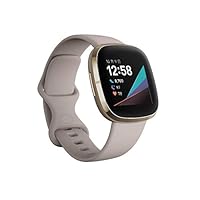Facebookは密かにスマートウォッチを作ってる。来年売り出す計画してる。
Facebook is secretly building a smartwatch and planning to sell it next year
The device would have messaging and fitness features
それはメッセージングとフィットネスの機能を持つようです。
Illustration by James Bareham / The Verge
Fitbit
新品 ¥33,736
Amazon.co.jpで詳細を見る
Facebook is building a smartwatch as part of its ongoing hardware efforts, according to a new report from The Information. The device is said to be an Android-based smartwatch, though the report does not say whether Facebook intends for the device to run Google’s Wear OS. It also says Facebook is working on building its own operating system for hardware devices and that future iterations of the wearable may run that software instead.
The Informationから出た新しいレポートによれば、Facebookは自身が進めているハードウェアへの取り組みの一部として、スマートウォッチを作っています。 その機器はアンドロイドベースのスマートウォッチであると言われています。 しかし、このレポートではFacebookがその機器でGoogleの Wear OSを動作させる意図があるとは言っていません。
The smartwatch would have messaging, health, and fitness features, the report says, and would join Facebook’s Oculus virtual reality headsets and Portal video chat devices as part of the social network’s growing hardware ecosystem. Facebook is also working on branded Ray-Ban smart glasses to come out later this year and a separate augmented reality research initiative known as Project Aria, which is part of the company’s broader AR explorations it’s been working on for some time now. Facebook declined to comment regarding any planned smartwatch projects
このスマートウォッチは、メッセージングと健康、そしてフィットネスの機能を持つことになるとレポートは言っています。 そして、ソーシャルネットワークの成長するハードウェアエコシステムの一部として、Facebook の Oculus バーチャルリアリティヘッドセットとPortalビデオチャット機器に組み込まれます。 Facebookは今年後半に出すRay-Banブランドのスマートグラスや、プロジェクトAriaとして知られる、しばらくの間取り組んできた同社の幅広いAR調査の一部である別の拡張現実研究イニシアチブにも取り組んでいます。 Facebookはいかなるスマートウォッチのプロジェクトの計画についてコメントを控えました。
The social networking giant’s hardware ambitions are no secret. The company has more than 6,000 employees working on various augmented and virtual reality projects and as part of existing hardware divisions like Oculus and Portal, as well as experimental initiatives under its Facebook Reality Labs division, Bloomberg reported last month. And although Facebook has not expressed a strong interest in health and fitness devices in the past, the company does have a track record in wearables with its Oculus headsets and forthcoming smart glasses.
ソーシャルネットワーク大手のハードウェアの野心は秘密ではありません。 同社では6千人以上の従業員が、OculusやPortalのような既存のハードウェア事業部の一部として、Facebook Reality Labs 事業部と同様に、様々な拡張および仮想現実プロジェクトに従事していると、Bloombergが先月報告しました。 また、Facebookはこれまで健康とフィットネス機器に強い興味を示しませんでしたが、同社はOculusヘッドセットと今後のスマートグラスを使ったウェアラブルに実績を持っています。
- a track record - 実績
- forthcoming - 今後の
Facebook also acquired the neural interface startup CTRL-Labs in 2019. CTRL-Labs specialized in building wireless input mechanisms, including devices that could transmit electrical signals from the brain to computing devices without the need for traditional touchscreen or physical button inputs. The startup’s intellectual property and ongoing research may factor into whatever wearables Facebook builds in the future — including a smartwatch, smart glasses, or future Oculus headsets.
FacebookはまたニューラルインタフェーススタートアップのCTRL-Labs を2019年に買収しています。 CTRL-Labsは無線の入力機構の構築に特化しました。 脳からコンピューティングデバイスへ、従来のタッチスクリーンや物理的なボタンの入力が必要なく、電気信号を送信できる機器を含んでいます。 このスタートアップの知的財産と進行中の研究は、Facebookが将来作るウェアラブル機器がどのようなものであれ、考慮するかもしれません。
元記事は以下からどうぞ。
日本の探査機はやぶさ2が小惑星のサンプルを地球へ
Japan's Hayabusa2 probe returns its asteroid sample to Earth
BEHROUZ MEHRI/AFP via Getty ImagesJapan’s Hayabusa2 probe has successfully returned an asteroid sample to Earth more than a year after first touching down on Ryugu. JAXA has confirmed that the sample capsule touched down in Australia in the early morning of December 6th local time. The cargo carrier had a relatively lengthy descent, starting its burn through the atmosphere at about 12:28PM Eastern before opening its parachute about 6.2 miles above the Earth and floating gently to terra firma.
日本の探査機「はやぶさ2」が、りゅうぐうに初めて着陸してから1年以上かかって、その小惑星のサンプルを地球へ持ち帰ることに成功しました。 JAXAはサンプルのカプセルが12月6日早朝にオーストラリアに着地したことを確認しました。 このカーゴは、比較的長い降下を行いました。東部時間で午後12時28分頃に、約6.2マイル上空でパラシュートを開く前、大気圏を通って燃え上がり、地上にそっと降り立ちました。
The operation was “perfect,” JAXA said.
「完璧な帰還だった」と、JAXAは言いました。
The probe first landed on Ryugu in February 2019 to capture asteroid material by firing a “bullet” into the surface, kicking up dust and rocks. It was originally supposed to have performed that mission in October 2018, but updated surface data prompted a change in strategy. Hayabusa2 itself will next study the tiny asteroid 1998 KY26, although the probe isn’t expected to arrive until July 2031.
この探査機は、りゅうぐうに2019年の2月にはじめて着陸しました。その表面へ「弾丸」を撃ち込んで、小惑星の素材、舞い上がる塵や砂を採取するためです。 これはもともと2018年10月のミッションで行わたはずでしたが、更新された表面のデータが戦略の変更を示したのです。 はやぶさ2自身は次の調査として、小さな小惑星1998 KY26 へ向かいますので、この探査機は2031年の7月まで戻ってきません。
Provided the asteroid samples pan out as promised, they could be very valuable. Ryugu could help understand the nature of the early Solar System and explore the possibility that asteroids seeded the Earth with organic matter. This won’t be the only mission of its kind, either. NASA’s OSIRIS-REx mission recently captured its own asteroid sample and should return it in September 2023. Don’t be surprised if humanity learns a lot more about its celestial neighborhood in the next few years.
採取した小惑星のサンプルは、とても価値があるものだと約束されています。 りゅうぐうは初期の太陽系を理解するため、そして、小惑星が有機物を地球に撒いた可能性を探るために役立ちます。 これは、この種のただ一つのミッションではありません。NASAもまた、OSIRIS-REx ミッションが、その独自の小惑星サンプルを採取し、2023年9月に戻ってきます。 もし人類が今後数年間のうちに隣の天体についてより多くのことを学ぶことになったとして、それは驚くことではありません。
Today (12/6) at 04:31 JST, all operations related to the re-entry of the capsule have ended. The operation was perfect. We will now move into science observation operations, and observe the Earth & moon with scientific instruments.
— HAYABUSA2@JAXA (@haya2e_jaxa) December 5, 2020
元記事は以下からどうぞ。
D-Waveが次世代量子アニーリングチップをリリース
D-Wave releases its next-generation quantum annealing chip
What's it take to make a chip with over a million Josephson junctions?
百万以上のジョセフソン接合でチップを作るために、何が必要なのでしょう?
- Josephson junctions - ジョセフソン効果
Today, quantum computing company D-Wave is announcing the availability of its next-generation quantum annealer, a specialized processor that uses quantum effects to solve optimization and minimization problems. The hardware itself isn't much of a surprise—D-Wave was discussing its details months ago—but D-Wave talked with Ars about the challenges of building a chip with over a million individual quantum devices. And the company is coupling the hardware's release to the availability of a new software stack that functions a bit like middleware between the quantum hardware and classical computers.
本日、量子コンピュータ企業 D-Waveが、次世代量子アニーリングの可用性を発表しています。 これは量子効果によって、問題の最適化と最小化を解決することに特化したプロセッサです。 このハードウェア自身は驚きには値しません ― D-Waveは先月この詳細について議論していたため ― しかし、D-Waveは百万以上の量子デバイスによるチップ構築へのこの挑戦について Arsに語りました。 同社は、量子ハードウェアと従来のコンピュータの間でのミドルウェアのように機能する新しいソフトウェアスタックの可用性に、ハードウェアのリリースを結びつけています。

動かして学ぶ量子コンピュータプログラミング ―シミュレータとサンプルコードで理解する基本アルゴリズム
Eric R. Johnston(著), Nic Harrigan(著), Mercedes Gimeno-Segovia(著), 丸山 耕司(監修), 北野 章(翻訳)
新品 ¥3,960 ![]() 1個の評価
1個の評価
Amazon.co.jpで詳細を見る
Quantum annealing / 量子アニーリング(量子焼きなまし法)
Quantum computers being built by companies like Google and IBM are general-purpose, gate-based machines. They can solve any problem and should show a vast acceleration for specific classes of problems—or they will, as soon as the gate count gets high enough. Right now, these quantum computers are limited to a few-dozen gates and have no error correction. Bringing them up to the scale needed presents a series of difficult technical challenges.
グーグルやIBMのような企業によって作られてきた量子コンピュータは一般目的のもので、論理回路に基づく機械です。 それらは、あらゆる問題を解くことができます。また、すぐにでも論理ゲートの数が十分に大きくなるため、特定の分野の問題について莫大な加速を見せるはずで、またそうなることでしょう。 現在、これら量子コンピュータは数十の論理ゲートに制限されており、誤り訂正機能がありません。 それらを必要なスケールまで引き上げることは、一連の難しい技術的課題を提示しています。
D-Wave's machine is not general-purpose; it's technically a quantum annealer, not a quantum computer. It performs calculations that find low-energy states for different configurations of the hardware's quantum devices. As such, it will only work if a computing problem can be translated into an energy-minimization problem in one of the chip's possible configurations. That's not as limiting as it might sound, since many forms of optimization can be translated to an energy minimization problem, including things like complicated scheduling issues and protein structures.
D-Waveのマシンは一般目的ではありません。技術的には量子アニーリングを行いますが、量子コンピュータではありません。 このハードウェアの量子デバイスの別の構成に対して、低エネルギー状態を見つける計算を行います。 このように、コンピューティングの問題は、このチップの可能な構成のうちのひとつの中におけるエネルギー最小化問題に変換できる場合にだけ動作します。 これは、想定されるほどの制限ではありません。多くの最適化の形式は、エネルギー最小化問題に変換できるためです。 それには、複雑なスケジューリングやタンパク質の構造などのようなことが含まれます。
※ 以降は原文サイトで確認してください。
元記事は以下からどうぞ。




